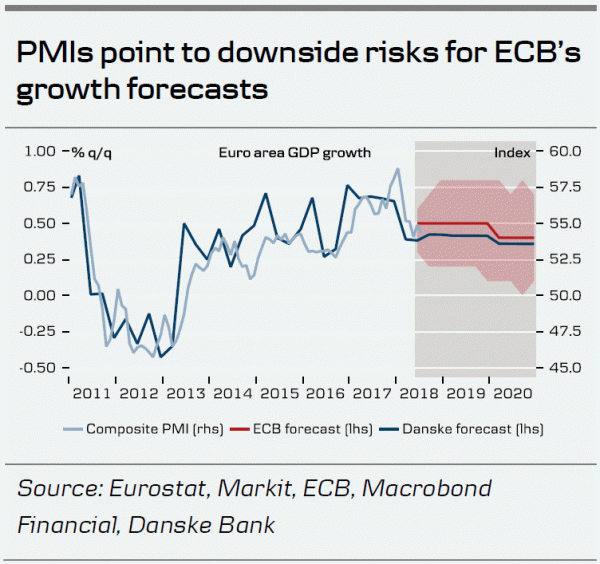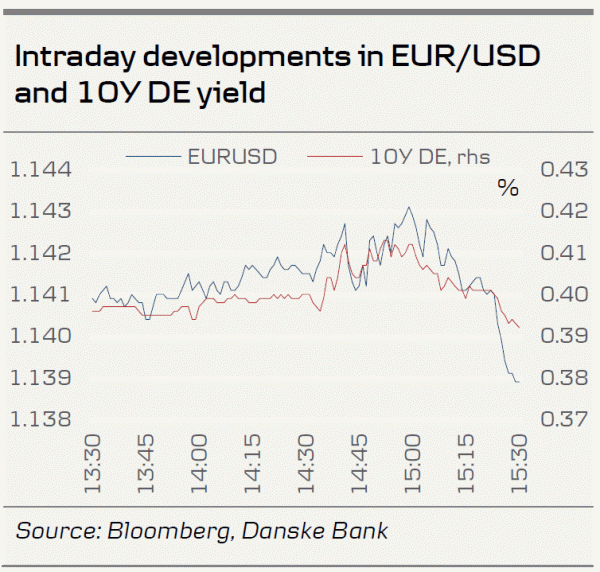- The ECB did not formally announce an end to the APP by the end of the year. There were no questions at the press conference on the first rate hike.
- The strong forward guidance of ‘rates remain at present levels at least through the summer of 2019’ remains.
- Markets moved mainly sideways during the press conference. The next ECB meeting on 13 December 2018 is likely to lead to a significant market reaction, as significant decisions have to be taken.
Politics getting in the way
ECB President Mario Draghi provided some interesting assessment during the press conference. He acknowledged that recent incoming data has been weaker than expected but tried to soften this by putting it into the context of growth returning to potential from the elevated levels last year and some country-specific/transitory factors affecting momentum in Q3. We see scope for a political will to end QE here playing into the assessment and acknowledging downside risks would probably complicate the policy change communication. The same downside risks were mentioned as last time – financial markets, emerging markets and protectionism – but overall the ECB still sees the growth risks as broadly balanced and, therefore, it is still on track to end the QE programme by the end of this year.
The ECB’s language on the assessment of the inflation outlook remains broadly unchanged. The ECB still draws strong confidence from rising negotiated wages (meaning that wage increases are of a more permanent nature), a tightening labour market and high capacity utilisation. Interestingly, the statement left out the part regarding ‘receding uncertainty around the inflation outlook’, which on balance could be interpreted as a dovish signal in light of recent core inflation misses.
Regarding Italy, Draghi stressed that it is so far more a fiscal discussion, rather than one of economic policy. He expressed confidence that an agreement will be found but cautioned that Italian interest and lending rates for households and firms have gone up and credit standards have tightened somewhat, meaning that the room to expand the budget as the government plans is getting smaller.
Draghi also refrained from giving any indication on the capital key update but tried to downplay the importance. We beg to disagree, as this matters for the reinvestment strategy.
The December meeting will be a very interesting one, where the ECB will formally end QE, outlining the reinvestment strategy including the capital key, update of staff projections (which may contain a downward revision to 2018 growth projection) and the inflation assessment, particularly if downside misses persist.
Markets
FX: distant hikes keep EUR/USD heading for 2018 lows
Even though the ECB refrained from introducing downside growth risks and maintained its relatively upbeat stance on inflation (both possible sources of EUR support), the EUR reaction was minimal and any initial support quickly faded with EUR/USD settling below 1.1450. In our view, today’s message underlines that it is still far too early for the ECB ‘normalisation’ path to provide more broad-based support to the single currency: we are simply too far away from the point in time when rates could possibly be raised for the FX market to care. Currently, the ECB is focused solely on ending QE and notably the lag to when rates will be lifted is both long and variable. That is there may be a political will to end QE but the ability to start hiking rates, which is the key to the FX-market reaction, remains distant. Further, the potential to start an outright hiking cycle may be questioned. Meanwhile, the carry lure of USD is helping keep USD bid despite the greenback’s somewhat wobbly safe-haven properties during the recent risk sell-off. In addition, Italy remains a factor placing a lid on EUR rather than a significant negative factor at this stage. Thus, we see EUR/USD heading for a test of the 2018 lows (support at 1.1301, 15 August low) and more broadly to be range bound around 1.15 ahead of year-end.
Fixed income: more range trading to come
Fixed income markets traded mostly sideways (10Y Bund within 2bp range), with no news (as expected) on the end of QE, the reinvestment strategy and capital key discussions. We believe the 10Y Bund will continue to stay range bound and see very limited risk of a taper tantrum on the back of a formal decision to end QE.















